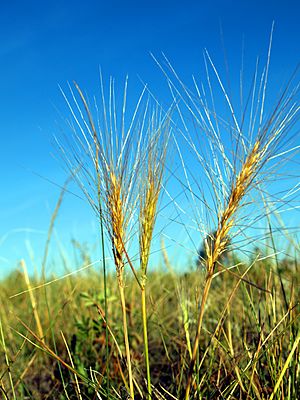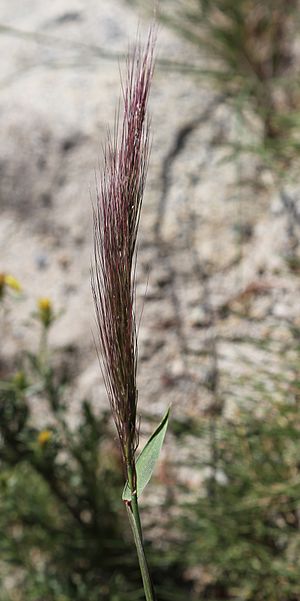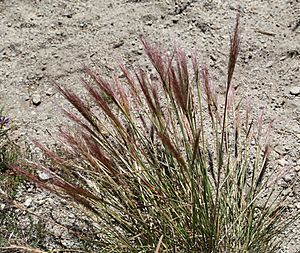Squirreltail facts for kids
Quick facts for kids Squirreltail |
|
|---|---|
 |
|
| Scientific classification | |
| Genus: |
Elymus
|
| Species: |
elymoides
|
| Synonyms | |
|
Sitanion hystrix |
|
Elymus elymoides, also known as squirreltail, is a type of wild rye grass. This plant grows naturally across most of North America, especially west of the Mississippi River. You can find squirreltail in many different places, from cold mountain areas to dry desert lands and open grasslands.
Contents
What is Squirreltail Grass?
Squirreltail is a perennial bunch grass. This means it lives for more than two years and grows in clumps. It usually reaches about 0.5 metres (20 in) (around 20 inches) tall. Its stems stand straight up and are solid. The leaves can be flat or rolled.
How Squirreltail Looks
The plant's flower cluster, called an inflorescence, can be up to 15 centimetres (5.9 in) (about 6 inches) long. It stands stiff and straight. Each small part of the flower cluster, called a spikelet, is about one or two centimeters long. But the spikelets also have long, pointy parts called awns. These awns can be up to 9 centimeters (about 3.5 inches) long!
When the plant is mature, these long awns stick straight out. This makes the whole flower cluster look like a bottlebrush. This shape helps the seeds spread easily when the wind blows them. When the plant is young, its flower cluster is smaller and has a reddish color.
Squirreltail as Food for Animals
This grass is considered good food for animals like sheep. It is best for them to eat during the winter. At that time, the grass is small and green. As the plant grows and its awns become long and sharp, it is not as good for animals to eat. The sharp awns can be uncomfortable for them.
Squirreltail and Other Plants
The Elymus group of plants, which includes squirreltail, belongs to the Poaceae family. This is the grass family, and it's very important for people around the world. Many important foods like wheat, rice, and barley come from this family. Grasses have been around for about 55 million years!
Competition with Invasive Plants
Squirreltail grass sometimes has to compete with plants that are not native to its area. These are called invasive species. One example is cheat grass (Bromus tectorum). When cheat grass grows near squirreltail, squirreltail doesn't grow as well. This is because cheat grass is very good at finding and using water, especially in dry places like the Great Basin. This competition means that squirreltail might not be as strong or healthy when cheat grass is around. Other types of Elymus grass also have this problem.
Squirreltail also competes with another invasive plant called crested wheatgrass (Agropyron cristatum). When crested wheatgrass is planted, it can harm older squirreltail plants. However, young squirreltail plants (seedlings) can compete well with crested wheatgrass.
Growing Squirreltail Grass
Sometimes, people plant crested wheatgrass to help restore land. If they do this, planting squirreltail grass alongside it can be helpful. This can stop the crested wheatgrass from taking over the whole area and forming a monoculture (where only one type of plant grows).
Squirreltail might grow better if it's planted alone, without other plants competing with it. This has been seen with another type of Elymus grass called Elymus nutas. However, even if squirreltail grows well by itself as a food source, growing only one type of plant can reduce how much carbon goes into the soil. It can also make the soil less healthy over time. So, when growing squirreltail, it's important to think about how it affects the soil and how it competes with other plants.
Types of Squirreltail Grass
There are different types of squirreltail grass, called subspecies. These are:
- E. e. ssp. brevifolius - This type is found in many places.
- E. e. ssp. californicus - This type grows in the western part of the area where squirreltail is found.
- E. e. ssp. elymoides - This type is also found in many places.
- E. e. ssp. hordeoides - This type is mostly found in the Pacific Northwest region.
Images for kids





